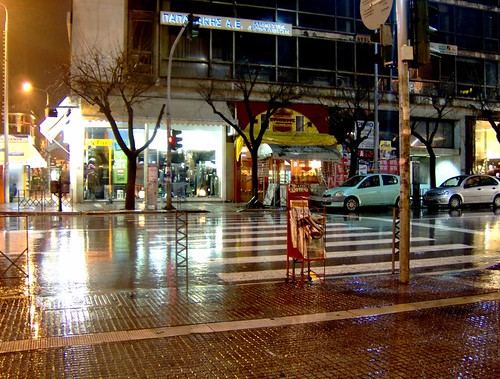
Taken yesterday near the sea front: it's a statue of some kind whose name escapes me.

Winter cafe on the sea front.
Teaching, journalism, photography and the like.

However, a nice, new shiny application by Flickr has made this even simpler. As many of you know, you can label different parts of your photos when you post them to Flickr. So, this is a great opportunity or students to learn and practice naming everyday objects.
When you click on your picture, look for the Add Note option which is above the image, on the left-hand side. Then just place the square where you want and add a description.
The potential for this technique doesn't just end with learning languages, it could be used in all kinds of learning situations where you need to know the different parts of an object. Imagine using it in biology lessons to name bones, in architecture to show different features etc. It is a great way to revise your knowledge using real life examples.



Taken on the number 56 bus whilst coming back home. I think the other passengers thought I was crazy still, it was worth the stares.

To contribute contact mywalks@northumbria.ac.uk."
I thought I'd talk again about a teaching idea that has really been a major help to my students. It combines the two great traits of any good idea; it's easy and it's quick. As most language art teachers know one of best routes to proficiency in a language, be it a foreign one or your own is extensive reading.
The problem is that for many students the idea of reading literature, on top of all the other stuff they have to do sounds more like punishment than anything else. Over the years I've pleaded, begged, threatened, demanded and any number of other verbs my students to read outside the curriculum, often to no effect. However, last year I hit upon a method that gets my students to read more. Instead of asking them to read, say a chapter (WHATTTTT, ARE YOU KIDDING????) I simply say I want them to do 20 minutes per week extra work. Hardly, a huge sacrifice, even for my over stretched, time - famished teenage students.
Basically, the idea is that the students listen to an audio book whilst following it in printed form. In this way, even a chapter can be done in less than half an hour. Also, it can be done anywhere, if you have an mp3 player or mobile phone with mp3 capability the you can listen on the bus, in bed, lounged out in front of the TV etc. Also for foreign language students the ability to see what is being said as well as listen to it makes the whole task much easier.
The audio books can be downloaded from any number of sources. For those of you interested in the likes of Dickens, Austin, Wilde and the like, go to Librivox or Gutenberg.
For those of you with more modern tastes then a quick visit to TorrentSpy and the like via BitComet is more likely to get you what you want.
Just remember to make sure you are downloading the full, unabridged version.
 "In fact, one of the saddest but most common conditions in elementary school computer labs (when they exist in the developing world), is the children are being trained to use Word, Excel and PowerPoint,"
"In fact, one of the saddest but most common conditions in elementary school computer labs (when they exist in the developing world), is the children are being trained to use Word, Excel and PowerPoint,"Mr Negroponte said.
"I consider that criminal, because children should be making things, communicating, exploring, sharing, not running office automation tools."
Click here for the rest of the article.
This is my sentiment exactly as I believe that the most students need is how to use a basic word processing package in order to put down their thoughts. All the really useful stuff that we can use to learn from the internet does not need Office. Blogging, vlogging, photo sharing, creating video, podcasting, wikis, and the like are the applications that will give our students the chance of getting a first class education. If, at some point they require a knowledge of Office tools then I'm sure they'll pick up the necessary skills in a matter of weeks.
But just teaching office automation tools, especially to younger learners is like teaching somebody to drive by letting them only learn the Highway Code and three-point turns.
